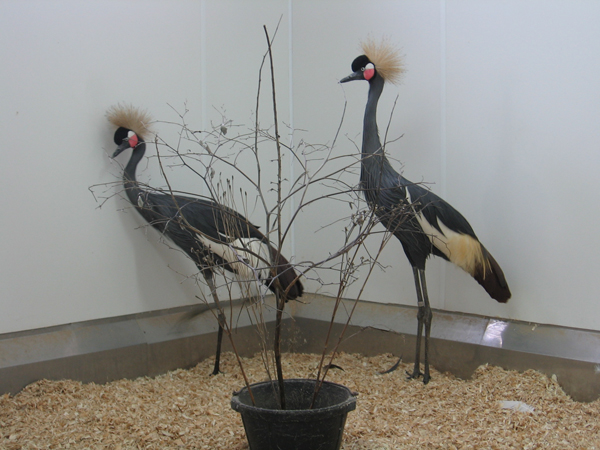
The International Crane Foundation’s Black Crowned Cranes Djoudj (pronounced “Jude”) and Sahel with their “exhibit furniture,” or cut, dried prairie grasses in buckets of sand. Alyssa notes that the cranes “like to hide behind them and also pull the grasses out and toss them around. It’s one of their favorite activities, really.” View more enrichment photos from our flock on Facebook.
Learn how you can help by purchasing a gift card or donating to our crane enrichment program!
Each week this winter, our aviculturists provided our captive crane flock with regular sources of environmental enrichment. Zoos around the world provide enrichment for their animals to help maintain both their physical and psychological health. Enrichment can include a wide variety of objects and scenarios. Ultimately, enrichment is any item or situation that promotes the expression of natural behaviors in a captive animal.
A key component of a successful enrichment program is novelty. If an object is overused it becomes less interesting and may no longer have a positive effect on behavior. In order to maintain the novelty of an item, we vary the type of enrichment provided to our cranes. Occasionally, we will offer items that require problem-solving skills, such as searching for treats buried in soil, snow or sprouting grass. We also make changes to the animal’s exhibit and alter the environment by adding potted plants or temporary ponds. Our favorite activity includes providing new foods not normally included in the cranes’ diet like crickets or pumpkins. Sensory enrichment stimulates not only their visual, and tactile senses, but also their auditory and olfactory abilities, such as playing pre-recorded bird calls or introducing feathers from another crane species into their enclosure.
Thanks to a recent donation from the Henry Vilas Zoo in Madison, Wisconsin, we have been able to purchase additional items for our enrichment program, including novel treats, toys and substrates like straw, grass and mulch. We have already begun to notice that certain cranes prefer certain items, which will help us develop our enrichment program in the future. For example, the Demoiselle Cranes find a pile of straw boring, while the White-naped Cranes love to rearrange the straw. This information about the cranes’ preferences can help us provide the birds with the enrichment items that are most beneficial for a happy, healthy crane flock!
Story submitted by Alyssa Lochen, Crane Conservation Department Intern
